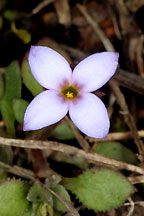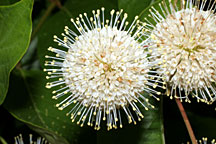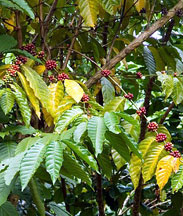professor of botany
and director of the T. M. Sperry Herbarium, Pittsburg State University, Pittsburg, KS.
 A small bluet
A small bluet
While hiking at Wildcat Glade (just at the south edge of Joplin) in late February, I found my first wildflower of the 2007 spring (very early spring) season. After a few warm days, the plant quickly grew and flowered. This small species is Hedyotis crassifolia (=Houstonia pusilla) better known as small bluets that grow to about 2-3 inches tall. It can be found in open woodlands, glades, prairies, roadsides, fallow fields, and lawns. Sometimes a lawn may appear blue due to the thousands of plants growing in it.
 One species of the Madder Family, Buttonbush (Cephalanthus occidentalis) is a shrub in which the flowers occur in spherical heads.
One species of the Madder Family, Buttonbush (Cephalanthus occidentalis) is a shrub in which the flowers occur in spherical heads.
The family to which the small bluets belong is the Rubiaceae, the Madder Family. Most species within the family have flowers with petals that are fused toward the base and four lobes. The family includes annual herbaceous (soft-stemmed) plants to shrubs and trees. It is a large cosmopolitan family of some 9000 species, mostly tropical in distribution. In Southwest Missouri and Southeast Kansas, there are some 19 species with most in the genus Galium, commonly called bedstraw or cleavers.
 The fruit of the coffee plant is a reddish berry, 10-15 mm. long, that grows in clusters.
The fruit of the coffee plant is a reddish berry, 10-15 mm. long, that grows in clusters.
The Madder Family is an important group of plants to humans. Coffee (Coffea spp.) is the most well-known member of this family originating in eastern Africa. Today coffee is grown primarily in Brazil, Colombia, Indonesia, Ivory Coast, and Ethiopia. Once discovered, it quickly spread around the world. By 1675 there were over 3000 coffee houses in England (although King Charles tried to have them closed, calling them “seminaries of sedition”). The first coffee house in North America opened in Boston in 1669.
Edward Lloyd, of Lloyd’s of London, opened a coffee house near the Thames River. It soon became a place where seafaring men drank coffee and gossiped about ships and their cargoes. Although insurance underwriters frequented the coffee house, Lloyd personally never was in the insurance business.
Another important member of the Madder Family was quinine (Cinchona officinalis) made from the bark of the tree. It was used by South American Indians for who-knows-how-long to cure malaria, then discovered by the Jesuits in the middle of the 1600s. But the Jesuits were so hated and feared in Europe that most segments of that population would not follow their advice to use quinine, believing it was a conspiracy to eliminate Protestants.
Oliver Cromwell had malaria. He would not take the “Jesuits’ powder” and died.
The word "malaria" is Italian in origin and means “bad air.” During World War I, more people died from malaria than at the hands of enemy fire. Today more than one million people die from malaria each year even though in 1944 quinine was synthesized reducing the need for the natural drug.
Ipecac (Psychotria ipecacuanha) has been used to induce vomiting for poisoning. Other species, including Gardenia, provide ornamentals. And a few species are used by South American Indians to induce hallucinations during religious ceremonies to contact the spiritual world.
For more information on wildflowers or plants in general, contact Dr. Timme here.
References:
Jackson, D. 1989. "Searching for Medicinal Wealth in Amazonia." Smithsonian 19: 94-103.
Klaytman, D. 1989. "Weeding Out Malaria." Natural History 98: 18-29.
Mann, J. 1992. Murder, Magic, and Medicine. Oxford, UK.
Roden, C. 1977. Coffee. Faber & Faber, London.
Swain, T. (ed.). 1972. Plants in the Development of Modern Medicine. Cambridge, MA.
Taylor, N. 1965. Plant Drugs That Changed the World. Dodd and Mead, NY.
Young, A. M. 1994. The World of Caffeine: The Science and Culture of the World’s Most Popular Drug. Routledge,NY.
Wrigley, G. 1988. Coffee. Longman, NY.






Comments